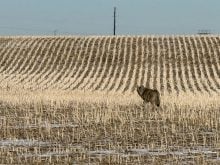The Saskatoon Crop Development Centre has created a bean variety so promising that seed production had to be delayed.
Saskatchewan Pulse Growers variety release manager Allan McDougald said demand exceeded supply of CDC Pintium breeder seed this year, so its release has been postponed until 2001.
“We couldn’t do it fairly,” said McDougald.
A small amount of seed was provided to nine growers in 1999. This year’s supply of breeder seed has been sent to Washington state where it will be multiplied and redistributed to Canadian growers in 2001.
Read Also

Manitoba grain elevator ownership expands
Carman-based Linear Grain buys Fannystelle elevator from Bunge, another three elevators sold to Morden’s BP & Sons Grain and Storage Inc.
All new varieties of pulse seed produced by the University of Saskatchewan’s Crop Development Centre are distributed to seed growers through the Saskatchewan Pulse Growers.
The commodity group has an all or nothing policy on seed distribution. Everybody gets the amount they want or nobody gets it.
Garth Patterson, executive director of Saskatchewan Pulse Growers, said CDC Pintium could become the flagship variety that allows Saskatchewan growers to compete in the bean industry.
“It has shown itself to be quite high yielding over a variety of environmental conditions.”
CDC bean and lentil breeder Bert Vandenberg developed the variety. As well as high yielding, Pintium matures early and is considered an upright type of pinto bean.
“It’s one that has kind of cracked a couple of our barriers here in Saskatchewan,” said Vanderberg.
The main barrier has been frost. Vandenberg said CDC Pintium performed well in 1999 trialsunder cool and wet conditions.
“Even at Rosthern it matured before the frost. It kind of caught the eye of a lot of people. If it does well again this year, look out. It will be one that makes an impact.”
Biggest and best
Seed breeder Henning MŸndel said he wouldn’t be surprised if Pintium becomes the dominant bean on the Prairies, especially for narrow-row production.
MŸndel, who works at Agriculture Canada’s Lethbridge Research Centre, said bean growers are just starting to get their hands on prairie-bred varieties. Until lately, all seed has come from the United States. In the next few years the prairie breeding program should start paying dividends.
Agriculture Canada has only one commercially available bean, a navy bean called AC Skipper. Two more red beans and a pink bean should be ready soon
Pink beans have fallen out of favor, but farmers may be interested in AC Earlyred and AC Redbond, said MŸndel.
Vandenberg said commercial supplies of new great northern, pinto and navy bean varieties from the Crop Development Centre will be available within the next two years and dozens more are in the pipeline.
He believes the new varieties will help maintain a 15 to 20 percent growth rate in prairie bean acreage over the next decade.
Farmers are expected to seed about 400,000 acres of beans in the 1999-2000 crop year.















